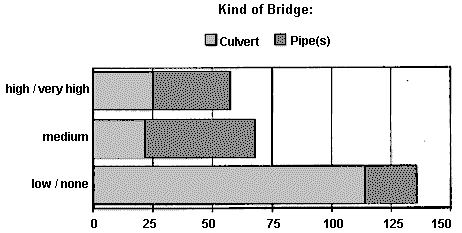 |
Last Update:
Thursday November 22, 2018
|
| [Home] |
|
Volume 19 Issue 1 Pages 1 - 61 (April 2002) Citation: Lafontaine, L. & Liles, G. (2002) Traffic Mortalities of the Otter and Road-Passes: a Database. IUCN Otter Spec. Group Bull. 19(1): 21- 24 Traffic Mortalities of the Otter and Road-Passes: a Database Lionel Lafontaine1 and Geoff Liles2 1 LutrAtlantica,
B.P. 1, 29670 Locquenolé, France, Phone: ++33 611 301 411,
EMail : lionel.lafontaine@wanadoo.fr,
www.reseau-loutres.org (received 21 January 2002, accepted 1 June 2002)
BACKGROUND Most experts agree to three main causes for the decline in otter numbers: pollution/contamination of the food chain, habitat destruction and accidental mortalities. This last cause is mainly due to road traffic in most countries. The deaths of otters on roads are a direct threat to otters, not only due to the impact it can have on existing local otter populations but also on the otter's ability to recolonise new areas. According to LILES and COLLEY (2001) in Wales, four factors seem particularly relevant:
For 10 years or more, in some countries, attempts at mitigation
measures have been made in order to significantly reduce otter road
deaths. These have taken the form of providing safe underpasses at
bridges or culverts (on new road schemes or at places where fatalities
have already occurred) or through maintaining or improving the
ecological continuity of a river (corridor function, prevention of the
'barrier effect', etc). Such measures have already been undertaken in
some areas of the UK (GREEN, 1991), Denmark (MADSEN,
1992, 1996) and France (LAFONTAINE,
1991, 1993;
LAFONTAINE et al., 1994), sites being identified through recognition
of black-spots for otters (LILES and COLLEY, 2001)
and/or through the wider collection of otter road death statistics (KÖRBEL,
1995; MACDONALD et al., 1999). Although some mitigation work has been carried out in some European countries, there has been little or no monitoring of these projects to see if they are effective as conservation measures, as well as cost effective. As written by R. Green (in press), it is true that 'mitigation measures will never prevent all otter road deaths', but also that 'while there have been a number of designs and specifications, there have not yet been many appraisals of mitigation measures published, although a number of such studies are underway'. The potential problem for otter populations from road deaths may be very significant in some parts of its range. A better understanding of effective mitigation measures, and their cost/benefit ratio, is urgently required. In Brittany, for example, results from a field study on Natura 2000 sites showed that 22% of 264 bridges surveyed would present a high or very high otter road death risk (mainly pipes or drains on small watercourses). However, appropriate mitigation measures (culverts or ledges, fencing) on so large a sample of bridges would be very costly (LAFONTAINE, 2001). Research on mitigation measures for otters carried out so far (LAFONTAINE, 1991, 1993; KÖRBEL 1995; MADSEN, 1996; GREEN 1991; CLARKE et al. 1999; LILES and COLLEY, 2001) has produced a range of solutions to the problem, including ledges, dry culverts and fencing. The measures themselves are interesting, and sometimes innovative, but specifications vary greatly (e.g. dry pipe or fencing? what size or length?, should it be in relation to bridge size?, is it operational?, is it always necessary?, etc).
Better cooperation and wider dissemination of knowledge and experience is now urgently needed. Not only is it neccesary to investigate the success of existing mitigation measures but also to research into the best designs for future use, to provide engineers and planners with data on current best recommendations. Finally, it is important that road authorities do not substitute the effectiveness or 'appropriateness' of mitigation measures for lower costs, as sometimes happens today (LAFONTAINE, 1991,2001). We should therefore like to propose a project to establish a cooperation and exchange programme between OSG experts, in order to compare respective situations and experiments into mitigation measures to prevent otter road deaths. For this we propose to create a DATABASE OF OTTER ROADPASSES, through a call for contributions from OSG members from all countries. The aim is to draw up an inventory of existing otter roadpasses, with biological, technical and financial data. As a first step we have designed an Initial Questionnaire (one voucher per roadpass). See below, file available from: lionel.lafontaine@wanadoo.fr. We will be very grateful if you will complete this questionnaire and e-mail it to the address above. Any pictures of the measures will be very useful. When enough data is available, a progress paper can be written together and published in further issues of this bulletin, with updated results available on an especially designed website.
REFERENCES Clarke, G., Howison, J., Hawker, B.H.,
O'Hagan, D. (Dir.) 1999. The Good Roads Guide: Nature Conservation
advice in relation to Otters. Design Manual for Roads and Bridges, the
Highways
Agency, HMSO London, 10/1, Part 9, HA 81/99,40pp. |
| [Copyright © 2006 - 2050 IUCN/SSC OSG] | [Home] | [Contact Us] |
